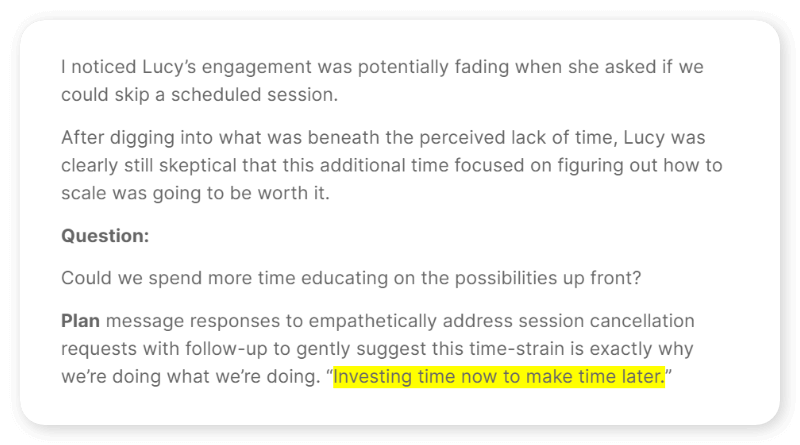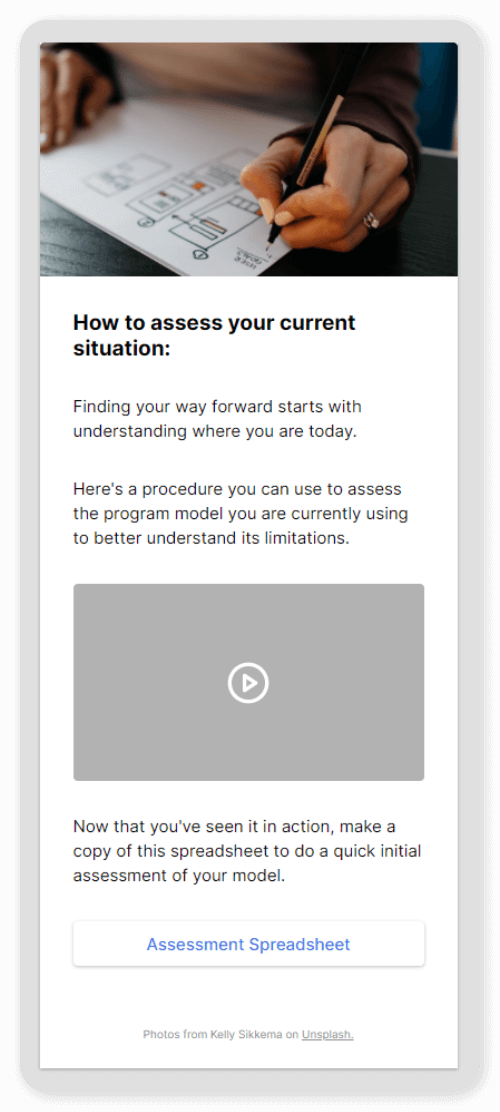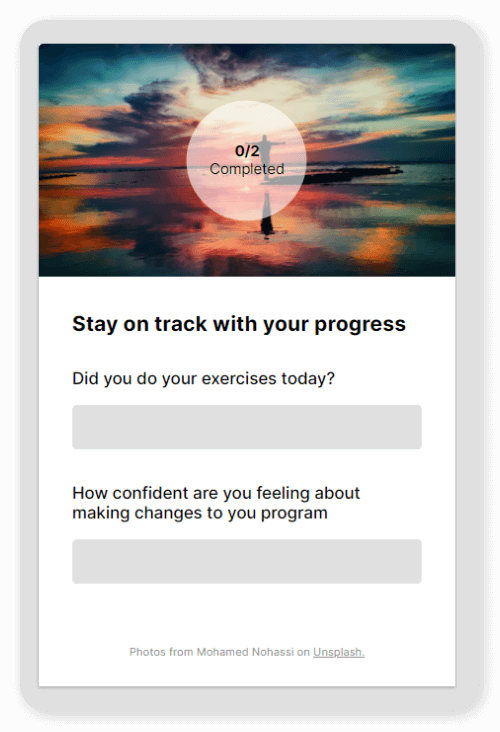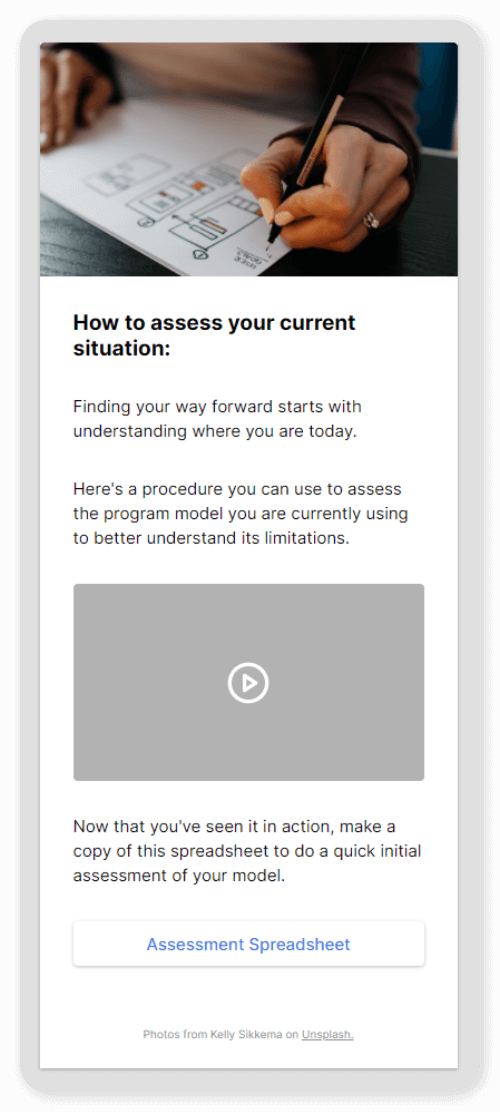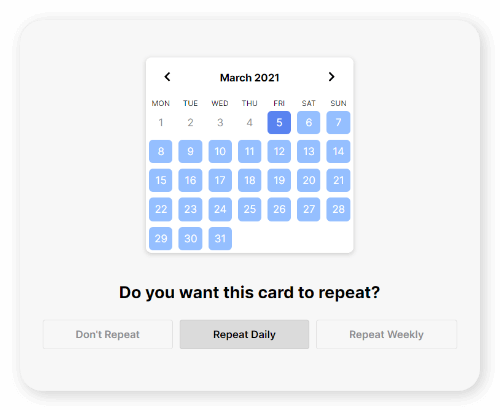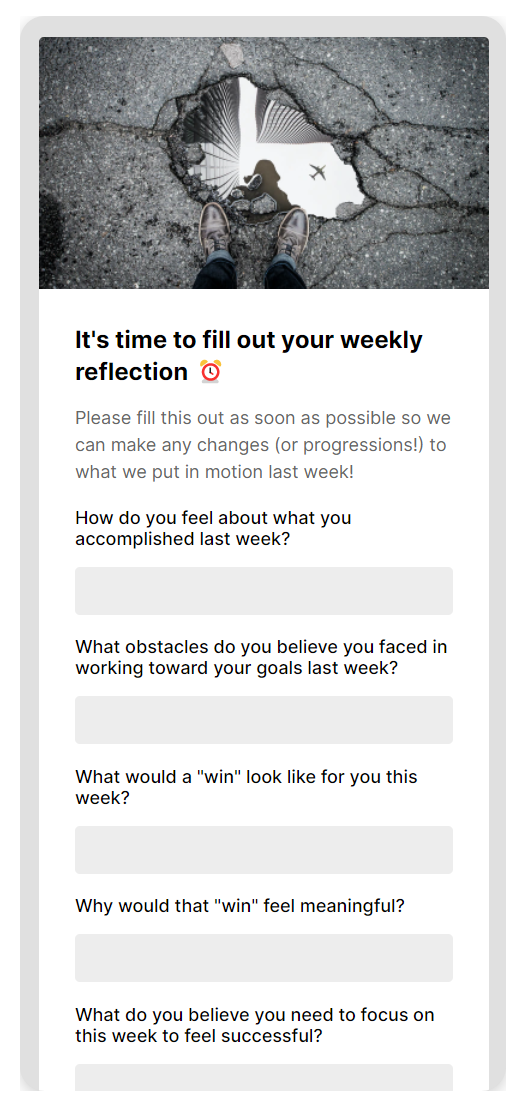by Phil Beene, Co-founder / Nudge Coach
In this post I walk through my favorite process for how to create a coaching program. Use it to get your ideas out of your head and into a complete coaching program outline so you can create a clear plan to build your next program faster.
I’ve believed the following two things to be true for a long time…
Coaching is the best way I know to help someone grow, reach goals and achieve the results they want
It’s been WAY too hard to create, launch and deliver a coaching program online
One piece of this puzzle is getting better online coaching tools into the hands of coaches.
Weaving together Facebook groups and email automations is a mess and creates a messy client experience.
Self-driven online courses aren’t engaging enough for people who care about getting their clients results. Information alone has never been enough to help people achieve the personal growth they yearn for. Learning Management Systems (LMS) that leave direct human connection and personal accountability out of the user experience entirely aren’t doing the job when true learning, new habit formation, and actual life changes are the goal.
We’ve seen enough of the low completion rates on these online courses, and that’s one of the reasons we built the Nudge platform. I should know. I I’ve been guilty of purchasing (collecting) online courses that remain unfinished to this day myself.
But along with better online coaching tools comes the work of building better, more engaging programs. So today I want to give you my 3 favorite exercises to help you plan your next coaching program faster, and my 3 favorite tips to help you build that program faster.
(If your program is mapped out and ready, the next essential step is creating a quality client onboarding experience to get your clients started with your coaching app successfully. Feel free to jump there now.)
For the purposes of this post, we’ll assume you’ve put in the time to understand who your program is for (your ‘ideal client’) and what it is they truly desire.
Here are a few client-centric questions that will help you put yourself in the right frame of mind before you start diving into the program planning phase...
What’s their ideal outcome or vision for themselves?
How do they desire to grow or improve by working with you?
What do they believe they ‘need’ to get there?
Where are they in their journey when they are ready to start with you?
What kind of experience (and engagement) would they expect (or like) along the way?
Now that you’re channeling the mindset of your ideal client 🤓, let’s dive into a few specific program planning exercises to get your ideas out of your head and onto the page.
How to Plan Your Coaching Program
Hesitation, fear of being judged, mental blocks - I’m convinced this category of personal barriers to sustained creativity has cost the world more great art, literature, and innovation than anything else.
Let’s make sure it doesn’t cost the world your next transformational coaching program.
There’s a mental model for the creative process that’s helped me stay persistent and finish a lot of projects that I otherwise would’ve probably abandoned en route.
I hope it helps you fight through any early blocks you hit as you create your coaching program as well.
Julian Shapiro calls it the “Creativity Faucet,” and describes it like this…
“Visualize your creativity as a backed-up pipe of water. The first mile of piping is packed with wastewater. This wastewater must be emptied before the clear water arrives.
Because your pipe only has one faucet, there’s no shortcut to achieving clarity other than first emptying the wastewater.
Let’s apply this to creativity: At the beginning of a writing session you must write out every bad idea that reflexively comes to mind. Instead of being self-critical and resisting these bad ideas, you must openly accept them.
Once the bad ideas are emptied, strong ideas begin to arrive.”
The point is this:
The beginning stages of creating a coaching program are always hard. It will not feel good at first. Keep pushing! Dump it all out on the page. Any page. Even if it sucks!
Trust me, this is just part of the process. The good news is once you’ve dumped it all out, things start flowing faster, easier and better.
To put it another way: It’s just easier to critique than it is to create.
So with that, let’s dive into our 3 program planning exercises that will help you create more complete coaching program plans that you feel more confident about, in less time.
How to Create A Coaching Plan
These 3 program planning exercises will help you get coaching plan ideas out of your head and mapped out in actionable form faster.
These exercises will also help you…
create extreme clarity in our own understanding of the purpose and stages of our program
and communicate the value of your program and what to expect clearly and concisely to clients and prospects
In short - clarity creates confidence - for you and your clients.
If you prefer video, you also can watch us talk through these program planning exercises.
Let’s get into it...
Exercise #1: Your Ideal Client Story
Purpose: Start Mapping Out Your Program Faster
Imagine you just finished working with your ideal client for your program, and they got the ideal result they were hoping to achieve from working with you.
Write the story (in narrative form) of your client’s experience from signing up, to their end result. Include all the details along the way.
How did they feel at different stages?
What insights did they uncover? What realizations did they come to?
Imagining your client’s full experience as much as possible, and writing about what they’re feeling (fear, uncertainty, excitement) and expecting at different steps along the way is key to getting the most from this type of exercise.
Once you’re done, go back through and highlight any “a ha moments” and key realizations that your client uncovered along the way.
These highlighted milestones are often great bullet points to ‘highlight’ when talking with prospects, or presenting on your website or in other promotional materials.
This also gives you a clear understanding of an ideal client journey and you may even start to see an order forming for how your program content could be mapped out.
But you aren’t there yet, the next exercise is all about making sure you get everything mapped in the right order and don’t skip any steps along the way.
Exercise #2: Working Backwards
Purpose: Complete Your Coaching Program Outline
This exercise is exactly what it sounds like.
Starting from your client’s ideal outcome - i.e. the result they want to achieve from working with you - now we are going to work backwards, step-by-step, in order to identify each critical milestone that a client needs to reach in order to get to that result.
After the desired outcome is written down, you’ll start by repeatedly asking yourself the same question and filling in responses until you’ve traced out every milestone along the way, “In order to get there my client must first…” like so…
The result should be a very detailed coaching program outline that you feel confident can get your clients from where they are today, to where they want to be.
Working through this exercise helps ensure your program doesn’t skip any steps along the way.
Once you identify all the mini-milestones along the journey, you can craft your specific coaching content and program steps to help guide your clients to reach each one.
A heads up - it can be pretty tough to think backwards step-by-step like this, so take your time.
If you’re anything like me you’ll find yourself circling back and adding little steps that you realize you skipped along the way, and moving things around several times.
But that’s okay because THAT’S EXACTLY WHAT THIS EXERCISE IS DESIGNED TO FORCE YOU TO DO!
Fill in all the gaps and the roadmap for your program will take shape in the form of a detail coaching program outline that you can use to start building your coaching program content.
Exercise #3: The Failure Premortem (from James Clear)
Purpose: Fill The Success Gaps In Your Coaching Program Plan
Finally, let’s dot our i’s and cross our t’s with one last exercise.
Where in Exercise #1, we imagined the ideal client and the ideal journey, in this exercise we want to imagine quite the opposite to help us identify where things can get off track.
This will help us create a plan to proactively mitigate threats to client success and create a more bulletproof program.
Here’s what we’re doing...
Imagine you just finished working with a client who did not have success in your program. Describe in detail what went wrong that led to them falling off track and/or not getting their desired outcome.
What might have happened in their lives to make staying on track more challenging for them?
How might they have been feeling at various points that contributed to them falling short?
The concept of doing a “Failure Premortem” comes from James Clear’s book Atomic Habits.
We’ve adapted it for creating coaching program plans because it gives you the tools to respond confidently when you start encountering challenges with keeping clients engaged and on track.
How to Build Your Coaching Program
3 tips to help you build your coaching program into Nudge Coach so you’re ready to launch faster.
As the Eisenhower quote goes…
““Plans are worthless, but planning is everything.””
What he meant was that the plan alone won’t do anything for you. You have to implement. You have to ship. You have to publish. You have to launch.
This section gives you a few specific places to start so you can “get your hands in the clay” as I like to say, and start building your program now.
We keep hearing story after story of clients saying that once they convinced themselves they were ready to start building, they started having fun and couldn’t believe how fast things started taking shape.
So set up your free Nudge Coach account now if you don’t already have one and let’s find a place to dive in and start creating...
Tip #1: Build the Essentials First
One thing that can paralyze you before you even start is to think you have to build everything at once.
Do not fall into this trap.
Take a few minutes and identify the few key pieces that are essential to build into the system to get one client through the process.
Map steps out as specifically as possible and give yourself a set block of time to build out just those pieces first.
Remember, Nudge is a personal coaching platform as well, so you can always fill in the rest as your first few clients go along in real-time, with direct personal communication.
Trust me, you’ll be happy you did this because I guarantee you’ll learn something important from getting a few personal reps with your first several clients.
Here are a few examples of the essentials you might build-in first to get yourself ready for clients…
A daily tracking protocol for simple accountability and building key habits (just build the habit first, you can add performance-based goals later).
A welcome video and key onboarding content to make sure you are humanizing the experience and setting clear expectations for what clients can expect from your coaching program.
Links to make sure clients can schedule their sessions, and take advantage of other key resources they’ll need along the way.
Tip #2: Don’t Paint Yourself into a Corner
Another reason to keep it simple when you start building your program into a system is that the more layers of complexity you “build-in”, the more difficult it becomes to iterate as you learn what works and what doesn’t.
Your ability to quickly iterate based on learnings SHOULD be one of your greatest assets with a system like Nudge, but you can make it difficult on yourself if you aren’t careful (see the Build, Measure, Learn feedback loop Eric Reis pioneered in The Lean Startup).
One way to keep it easy to iterate or even tailor things based on individual client needs as you start running clients through your program is to keep your coaching content and tracking protocols in separate cards.
For example…
While the vision of your idealized, beautifully interwoven tapestry of a client experience may be dancing through your head, the fact is you need some reps before you know what works best for your clients.
Keeping content cards and tracking cards separate at first makes it incredibly easy to make changes to either.
Once you get started, you’ll be especially happy you made it easy on yourself to create personalized versions of your tracking protocol for different clients because I can virtually guarantee you’ll run into a situation where that becomes valuable right out of the gate.
Tip #3: Build Your Own Coaching Program Templates
Optionality isn’t always all it’s cracked up to be. Too much flexibility can often lead to overwhelm instead of action. If you don’t typically nerd out over the psychology of choice and decision-making you might find this research on choice paralysis particularly enlightening.
That’s all to say, sometimes the creative process is best unleashed by putting clear guardrails on your process.
Creating your own templates to structure your content is a great way to give yourself the right limitations to help you more efficiently direct your creativity into productivity.
In your Nudge account, these are the first 3 card templates I recommend you create for yourself to accelerate your program building process.
Learning Module Template
Habit Tracker Template
Check-In Form Template
1. Learning Module Template
Your Learning Module Template sets a structure for the information and educational content you share at each step of your program to help guide your client to unlock the next ‘ah ha moment’ or milestone on their journey.
Here’s an example of a template card I’ve structured for a program I’ve developed with consistent video content.
The simple structure of feature image, headline, text blocks, video and button link give me the ability to very quickly ‘Duplicate’ this card and switch out the content for each subsequent step of my program.
Before you know it, I’ve got a full program built into a Sequence in Nudge that looks intentional, consistent and beautiful, which will impress my clients every time.
It almost makes it just a nice bonus that this Sequence will deliver automatically for me once I assign it to clients (but seriously, that saves me A TON of time on every new client).
2. Habit Tracker Template
As I explained in the previous section, I like to keep my tracking protocol separate from my content when planning a new program. It helps me personalize habit trackers more easily based on client needs, and iterate faster as I learn my way to better program-client fit.
Keeping it separate also makes it easy to create a dedicated template of a Habit Tracker Card that I can quickly duplicate to create new variations as needed.
I wouldn’t overthink this out of the gates, so my Habit Tracker Template may start by looking something like this example…
Again, this saves me time every time I need a little tweak or new variation. Just duplicate, update the name, customize the trackers to fit your program or client, save and assign.
3. Check-In Form Template
Finally, when I’m building a new program into Nudge, I also like to have a Check-In Form Template at the ready because it comes in handy in so many ways.
Having your clients assess how they feel they are progressing throughout the journey working with you is essential to your success and theirs. And this Check-In Form Template can be duplicated and customized to fit so many scenarios.
For example, during the course of your program you may have some or all of the following Check-Ins or Assessments:
Intro Assessment - to benchmark where your clients are when they begin their journey
Weekly Assessment - to regular assess progress towards certain outcomes in your programs, or stay on top of how your clients are feeling about their progress so you can more proactively intervene or make adjustments as needed
Exit Assessment - to determine how far your client has come on the journey. Are they satisfied? Could they be a candidate for a testimonial? To continue with a maintenance program? Or do they still have work to do and possible want to sign up for your core offering for a second time?
Reflections - to invite clients to reflect on certain learnings or experiences from the prior days or week to see if they are absorbing insights and experiencing growth as they (and you) had hoped
To make this template especially easy to create, there’s an example Check-In Card Template built directly into Nudge that you can start from. It was co-developed with the help of Laura Poburan, one of our friends and a stone-cold expert on getting impactful responses from clients on a regular basis.
What Makes Online Coaching Programs Successful?
So you want to grow and scale that online coaching program…
Whether you’re a coach, creator, consultant, or just an expert in something people want to learn how to do better (dominate in a video game, herd cats, whatever) I think online coaching is the best and most fulfilling way to share your expertise with the world, directly impact people’s lives, and build a scalable business online.
But here’s the catch...
It takes a bit more than building a great program to grow a successful online coaching business.
The good news is, you don’t need to guess what those things are because we do this every day… literally every day.
Once you’ve got a great program in place that’s built to guide your ideal clients to their ideal outcomes, the next two places to focus that consistently yield compounding returns are…
Creating an engaging client onboarding process
Maximizing your customer lifetime value
Succeed at both and you’ll be scaling an online coaching program, and recurring revenue business faster than you might expect.
Thanks for reading.




